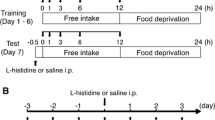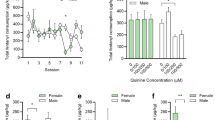Abstract
The effects of naloxone on fluid consumption by water-deprived rats trained to choose between a saline solution and water in a 15-min drinking test were examined. Rats of each sex were allocated to three groups and given access to 0.125% NaCl, 0.6% NaCl, and 1.7% NaCl, respectively, as the alternative to water. Under control conditions they drank substantially more of the hypotonic salt solutions than water, but drank slightly more water than hypertonic salt solution. Naloxone generally reduced fluid consumption, dose-dependently (0.01–10 mg/kg). In the cases of the two hypotonic solutions, the suppressant effect of naloxone was limited to saline solution. The usually low levels of water consumption were unaffected. In the case of the hypertonic solution, naloxone suppressed salt and water intakes by equivalent amounts. The effects of naloxone in the tests with the two higher salt concentrations depended upon sex. There was one example of a significant naloxone-induced reduction in saline preference (females; 0.125% NaCl v H2O). In other instances, saline preferences were not significantly modified. The results are briefly discussed in relation to current suggestions that naloxone may affect fluid consumption in ways which are taste-dependent (e.g., taste sensitivity, palatability, reward). An alternative view is also considered, that the effects of naloxone may be taste-independent, at least in the particular case of drinking in a two-choice test with saline and water.
Similar content being viewed by others
References
Bare JK (1949) The specific hunger for sodium chloride in normal and adrenalectomized white rats. J Comp Physiol Psychol 42:242–252
Brown DR, Blank MS, Holtzman SG (1980) Suppression by naloxone of water intake induced by deprivation and hypertonic saline in intact and hypophysectomized rats. Life Sci 26:1535–1542
Brown DR, Holtzman SG (1981a) Narcotic antagonists attenuate drinking induced by water deprivation in a primate. Life Sci 28:1287–1294
Brown DR, Holtzman SG (1981b) Opiate antagonists: central sites of action in suppressing water intake of the rat. Brain Res 221:432–436
Catalanotto FC, Schechter PJ, Henkin RI (1972) Preference for NaCl in the spontaneously hypertensive rat. Life Sci 11:557–564
Cooper SJ (1980) Naloxone: effects of food and water consumption in the non-deprived and deprived rat. Psychopharmacology 71:1–6
Cooper SJ (1982) Palatability-induced drinking after administration of morphine, naltrexone and diazepam in the non-deprived rat. Subst Alcohol Actions Misuses 3:259–265
Cooper SJ (1983) Effects of opiate agonists and antagonists on fluid intake and saccharin choice in the rat. Neuropharmacology 22:323–328
Cooper SJ, Holtzman SG (1983) Patterns of drinking in the rat following the administration of opiate antagonists. Pharmacol Biochem Behav 19:505–511
Ernits T, Corbit JD (1973) Taste as a dipsogenic stimulus. J Comp Physiol Psychol 83:27–31
Foster JA, Morrison M, Dean SJ, Hill M, Frenk H (1981) Naloxone suppresses food/water consumption in the deprived cat. Pharmacol Biochem Behav 14:419–421
Fregly MJ, Harper JM, Radford EP (1965) Regulation of sodium chloride intake by rats. Am J Physiol 209:287–292
Frenk H, Rosen JB (1979) Suppressant effects of naltrexone on water intake in rats. Pharmacol Biochem Behav 11:387–390
Hall WG, Blass EM (1975) Orogastric, hydrational, and behavioral controls of drinking following water deprivation in rats. J Comp Physiol Psychol 89:939–945
Jalowiec JE, Panksepp J, Zolovick AJ, Najam N, Herman BH (1981) Opioid modulation of ingestive behavior. Pharmacol Biochem Behav 15:477–848
Kuta CC, Bryant HU, Zabik JE, Yim GKW (1984) Stress, endogenous opioids and salt intake. Appetite 5:53–60
Lang IM, Strahlendorf JC, Strahlendorf HK, Lutherer LO, Barnes CD (1982) The effects of chronic administration of naltrexone on appetite and water exchange in rats. Pharmacol Biochem Behav 16:909–913
Leander JD, Hynes MD (1983) Opioid antagonists and drinking: evidence of K-receptor involvement. Eur J Pharmacol 87:481–484
Le Magnen J, Marfaing-Jallat P, Miceli D, Devos M (1980) Pain modulating and reward systems: a single brain mechanism? Pharmacol Biochem Behav 12:729–733
Levine AS, Murray SS, Kneip J, Grace M, Morley JE (1982) Flavor enhances the antidipsogenic effect of naloxone. Physiol Behav 28:23–25
Ostrowski NL, Foley TL, Lind MD, Reid LD (1980) Naloxone reduces fluid intake: effects of water and food deprivation. Pharmacol Biochem Behav 12:421–435
Reid LD, Siviy SM (1983) Administration of opiate antagonists reveal endorphinergic involvement in reinforcement processes. In: Smith JE, Lane JD (eds) The neurobiology of opiate reward mechanisms. Elsevier, Amsterdam, pp 257–279
Richter CP (1936) Increased salt appetite in adrenalectomized rats. Am J Physiol 115:155–161
Rockwood GA, Reid LD (1982) Naloxone modifies sugar-water intake in rats drinking with open gastric fistulas. Physiol Behav 29:1175–1178
Rockwood GA, Siviy SM, Reid LD (1981) Naloxone reduces fluid intake in rats with open gastric fistulas. Pharmacol Biochem Behav 15:319–321
Author information
Authors and Affiliations
Rights and permissions
About this article
Cite this article
Cooper, S.J., Gilbert, D.B. Naloxone suppresses fluid consumption in tests of choice between sodium chloride solutions and water in male and female water-deprived rats. Psychopharmacology 84, 362–367 (1984). https://doi.org/10.1007/BF00555214
Issue Date:
DOI: https://doi.org/10.1007/BF00555214




